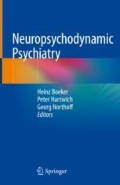Abstract
This chapter is about pathological anxiety in psychiatric disorders: phobic disorders, panic disorders, generalized anxiety disorder, and separation anxiety. We describe two typical case examples: agoraphobia and social phobia with all their complexity.
Neurobiological research emphasizes that the perception of new, threatening stimulus constellations generates an unspecific activity pattern in memory-storing associative cortical and subcortical structures. The activity of the HPA axis presents a protecting function in the sense of an emergency reaction. This has sustaining consequences for the functions of neurons and glial cells: gene expression of neurons, production of nervous growth factors, dendritic and axonal growth, development of dendritic spines and synaptic contacts, and reorganization of neural and synaptic connections in the brain.
Neuroimaging studies of the effects of psychotherapy in patients with anxiety disorders show that psychotherapy leads to a decrease of the differences between patients and healthy persons in the sense of normalization. This is not only interesting as a demonstration of the neurobiological effects of psychotherapy but also enables a better understanding of the effects and mechanisms of psychotherapy. Accordingly, in neuropsychodynamic psychotherapy not new or compensatory networks are developed, but instead functional networks are trained, regulated, and normalized, which also can be found in healthy persons. Especially a reduction of the amygdala activity is found in anxiety disorders. In some anxiety disorders, the PFC activity is reduced and on this way “normalized”; in others rather the control of the PFC on the amygdala is improved, without changes of the PFC activity. On this background the neurobiological models of anxiety especially start from a disturbed balance between hyperactive limbic emotional regions (amygdala and insula) and the dysfunctional cingulate control.
Access this chapter
Tax calculation will be finalised at checkout
Purchases are for personal use only
References
Beutel ME, Stark R, Pan H, et al. Changes of brain activation in pre-post-short-term psychodynamic in-patient psychotherapy: an fMRI study of panic disorder patients. Psychiatry Res Neuroimaging. 2010;184(2):96–104.
Bishop SJ. Neurocognitive mechanisms of anxiety: an integrative account. Trends Cogn Sci. 2007;11(7):307–16.
Bowlby J. The making and breaking of affectional bonds. I. Aetiology and psychopathology in the light of attachment theory. An expanded version of the fiftieth Maudsley lecture, delivered before the Royal College of Psychiatrists, 19 November 1976. Br J Psychiatry. 1977;130(3):201–10.
Brühl AB, Delsignore A, Komossa K, Weidt S. Neuroimaging in social anxiety disorder – a meta-analytic review resulting in a new neurofunctional model. Neurosci Biobehav Rev. 2014;47:260–80.
Brühl AB, Herwig U, Rufer M, Weidt S. Neurowissenschaftliche Befunde zur Psychotherapie von Angststörungen. Z Psychiatr Psychol Psychother. 2015;63(2):109–16.
De Masi F. The psychodynamic of panic attacks: a useful integration of psychoanalysis and neuroscience. Int J Psychoanal. 2004;85:311–36.
Diekhof EK, Geier K, Falkai P, Gruber O. Fear is only as deep as the mind allows: a coordinate-based meta-analysis of neuroimaging studies on the regulation of negative affect. NeuroImage. 2011;58:275–85.
Etkin A. Neurobiology of anxiety disorders: from neural circuits to novel solutions? Depress Anxiety. 2012;29(5):355–8.
Freud S. Studien über Hysterie. Gesammelte Werke Bd 1, vol. 1977. Frankfurt/M: Fischer; 1892–1899. p. 75–312.
Gabbard GO. Psychodynamic psychiatry in clinical practice. 5th ed. Washington, DC: American Psychiatric; 2014.
Goisman RM, Goldenberg I, Vasile RG, et al. Comorbidity of anxiety disorders in a multicenter anxiety study. Compr Psychiatry. 1995;36:303–11.
Greenson RR. Phobia, anxiety and depression. J Am Psychoanal Assoc. 1959;7:663–74.
Gross CT, Canteras NS. The many paths to fear. Nat Rev Neurosci. 2012;13(9):651–8.
Kendler KS, Neale MC, Kessler RC, et al. Childhood parental loss and adult psychopathology in women: a twin study perspective. Arch Gen Psychiatry. 1992;49:109–16.
Kiekegaard S. Der Begriff Angst. GW Abt 11/12. Gütersloher Taschenbücher. Gütersloh: Siebenstern; 1981. (Erstveröff. 1844) [893].
Kohn N, Eickhoff SB, Scheller M, et al. Neural network of cognitive emotion regulation–an ALE meta-analysis and MACM analysis. NeuroImage. 2014;87:345–55.
Kossowsky J, Pfaltz MC, Schneider S, Taeymans J, Locher C, Gaab J. The separation anxiety hypothesis of panic disorder revisited: a meta-analysis. Am J Psychiatry. 2013;170:768–81.
LeDoux J. The emotional brain: the mysterious underpinnings of emotional life. London: Weidenfeld & Nicolson; 1996.
Leichsenring F, Salzer S, Jäger U, et al. Short-term psychodynamic psychotherapy and cognitive-behavioral psychotherapy in generalized anxiety disorder: a randomized, controlled study. Am J Psychiatry. 2009;166:875–81.
Leichsenring F, Salzer S, Beutel ME, et al. Psychodynamic therapy and cognitive-behavioral therapy in social anxiety disorder: a multicenter randomized controlled trial. Am J Psychiatry. 2013;170:759–67.
Leichsenring F, Salzer S, Beutel ME, et al. Long-term outcome of psychodynamic therapy and cognitive-behavioral therapy in social anxiety disorder. Am J Psychiatry. 2014;171:1074–82.
Mentzos S. Lehrbuch der Psychodynamik. Die Funktion der Dysfunktionalität psychischer Störungen. 5th ed. Göttingen: Vandenhoeck & Ruprecht; 2011.
Paquette V, Levesque J, Mensour B, et al. “Change the mind and you change the brain”: effects of cognitive behavioral therapy on the neural correlates of spider phobia. NeuroImage. 2003;18(2):401–9.
Rüger U. Angst. In: Müller C, editor. Lexikon der Psychiatrie. 2nd ed. Heidelberg: Springer; 1986. p. S 43–8.
Sartre JP. Being and nothingness. An essay on phenomenological ontology. Translated by Barnes HE, New York: Philosophical library, Inc., L’é’tre et le néant. Essai d’ontologie phénoménologique (1943), Paris: Librairie Gallimard; 1956.
Scharfetter C. Allgemeine psychopathologie. 2nd ed. Stuttgart: Thieme; 1985.
Shear MK, Cooper AM, Klerman GL, et al. A psychodynamic model of panic disorder. Am J Psychiatry. 1993;150:859–79.
Stein MB, Walker JR, Anderson G, et al. Childhood physical and sexual abuse in patients with anxiety disorders and in a community sample. Am J Psychiatry. 1996;153:275–7.
Tabbert-Haugg C. Alptraum Prüfung, Gestörtes Prüfungsverhalten als Ausdruck von Schwellenängsten und Identitätskrisen. Stuttgart: Pfeiffer, Klett-Cotta; 2003.
Author information
Authors and Affiliations
Corresponding author
Editor information
Editors and Affiliations
Rights and permissions
Copyright information
© 2018 Springer International Publishing AG, part of Springer Nature
About this chapter
Cite this chapter
Hartwich, P., Boeker, H., Northoff, G. (2018). Anxiety Disorders. In: Boeker, H., Hartwich, P., Northoff, G. (eds) Neuropsychodynamic Psychiatry. Springer, Cham. https://doi.org/10.1007/978-3-319-75112-2_13
Download citation
DOI: https://doi.org/10.1007/978-3-319-75112-2_13
Published:
Publisher Name: Springer, Cham
Print ISBN: 978-3-319-75111-5
Online ISBN: 978-3-319-75112-2
eBook Packages: MedicineMedicine (R0)

